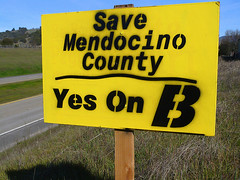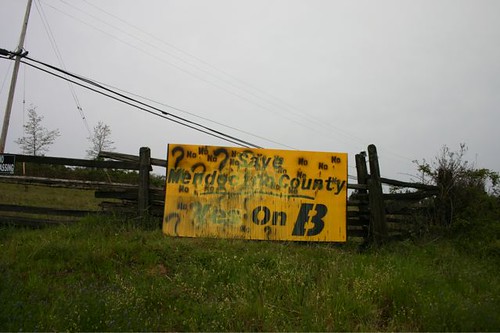But eight years later, some are campaigning to scale back the law, saying it's time to weed out pot profiteers. "We want to take that welcome mat away," said Ross Liberty, spokesman for Measure B, which goes before Mendocino County voters Tuesday. "What (Measure) B does is redefines who gets arrested and the 'who' will be medical patients that are growing more than six plants," said Laura Hamburg, who became active in the No on B campaign after her medical marijuana garden was raided.
The issue offers a glimpse into the murky world of medical marijuana in California, legal under state law, banned by the feds, and according to some reports, bringing some serious green into the Golden State. Using marijuana for medical purposes has been legal in California since 1996, when voters passed Proposition 215. But that law had only a sketchy mechanism for how marijuana would be produced and dispensed. State lawmakers subsequently allowed counties to issue ID cards to protect medical users from being prosecuted by local authorities. Each cardholder is allowed to have up to a half pound of dried marijuana or six mature marijuana plants, although local governments can set laws exceeding the state's limits. Meanwhile, federal authorities, who never recognized Proposition 215 and deny that marijuana has medicinal properties, have won a number of legal showdowns over the measure.
In 2000, Mendocino County voters approved Measure G, which had a 25-plant limit and permitted personal and recreational use, the latter a symbolic gesture since neither state nor federal laws allow personal pot use. The new law, Measure B, would repeal Measure G and set plant limits at state levels. (It's not entirely clear what that will mean since state guidelines are at issue in a Southern California court case.
The No on B side interprets the case as undermining Measure B. The Yes side disagrees, noting the case is under appeal.) Sheriff Tom Allman says the problem with Measure G is it gave the impression marijuana had been legalized in Mendocino County. "There's this perception that we're just a bunch of Cheech and Chong marijuana growers up here," Allman said. Blessed by ancient redwood groves and bordered by a breathtakingly beautiful coast, Mendocino County has long also been famous as a source of high-grade pot.
Estimates on how much money is generated by marijuana in Mendocino County and statewide vary; officials say it's hard to come up with a definite total since so much of the industry is undercover. Figures from the state's Campaign Against Marijuana Planting (CAMP) show more than 220,000 plants were seized in Mendocino County last year, up from about 136,000 the year before. Statewide, CAMP reported seizures of 2.9 million plants with an estimated wholesale value of $11.6 billion.
Hamburg, the daughter of former Rep. Dan Hamburg, grows medical marijuana for herself, her mother and her sister as well as a neighbor. She was raided last year by deputies who said they found an excessive number of plants. The charges were later dropped, leaving Hamburg determined to "work as hard as I could, as much as I could, so that no one would have to experience what I went through, which was devastating." Hamburg says there's no correlation between state seizure figures and county plant limits, pointing out that CAMP stats show Mendocino County ranked fourth in 2007 seizures. No. 1 was sparsely populated Lake County, which follows the state minimum of six plants, with nearly 483,000 plants seized. She argues that it's not Measure G that spurs marijuana growth in Mendocino County but its climate, topography and the institutional knowledge gleaned from decades of marijuana farming.
But Allman and others say cannabis became a lot less covert here after Measure G passed.
"It's in your face bad," said Allman.
These days, residents complain they can't sit in their backyards because the smell of the next-door marijuana patch is so strong, the sheriff said. In August, said Liberty, "it smells like pot everywhere. It just reeks." On the other side of the Measure B issue are George and Jean Hanamoto. Lavender and other carefully tended shrubs bloom in their attractive front garden on a wooded hillside in Mendocino County. And in the back yard are their marijuana plants, their characteristically spear-tipped leaves turned to the sky. Hanamoto, who is 74 and uses marijuana to relieve glaucoma and for back pain, said cutting plant limits to six would hurt people like him because growing conditions mean he can't always get the maximum out of each plant. Allman says the Hanamotos aren't the kind of people he'll be sending deputies after. He said he will continue to concentrate on large operations. Beyond that, "I want the rest of the state and possibly the nation to say, `Wow, we can't do whatever we want in Mendocino County,"' he said. But the Hanamotos aren't won over by arguments that Measure B will deter criminal operators. "The laws are there already," said Jean Hanamoto. "This is just to squash the little guy."
Copyright 2008 by KTVU.com.
The Associated Press contributed to this report. All rights reserved.






![[Graphic]: Forest Service Logo.](http://www.fs.fed.us/global-websites/images/logos/fs-shield-shadow-blk.gif)





























